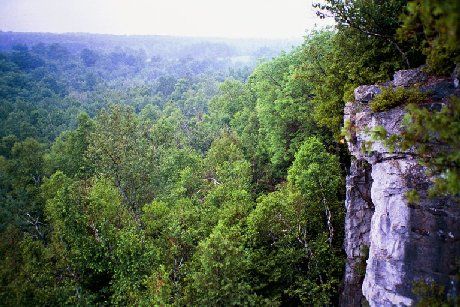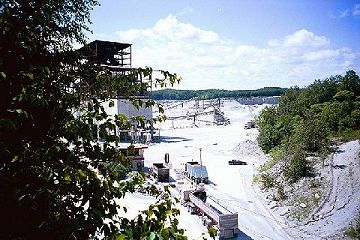Bruce Trail
|
|
The Bruce Trail is a hiking (and multi-use) trail in southern and central Ontario, Canada.
| Contents |
General
It follows the edge of the Niagara Escarpment, one of only twelve UNESCO World Biosphere Reserves in Canada, for more than 800 km (500 miles). The land the trail traverses is owned by the Government of Ontario, private landowners and the Bruce Trail Association.
Natural features
There are many waterfalls along the Bruce trail, where streams or rivers flow over the Niagara Escarpment. Niagara Falls, by far the most famous watercourse in the area, can be reached by a side trail of the Bruce Trail proper. There is also a wide range of plant and wildlife along the trail, including slow-growing centuries-old coniferous trees right on the limestone lip of the escarpment itself.
The Bruce Trail and the escarpment run through some of the most populated areas of Ontario, with an estimated 7 million people living within 100 km (62 miles). Golf courses, housing, and quarries are all examples of the threatening impact that this many people have on the natural environment. The popularity of the trail itself, especially near urban areas, and the careless attitude of many of its users also paradoxically threaten the quality and viability of the trail.
Route
The trail begins in the south in Queenston, Ontario, on the Niagara River, not far from Niagara Falls. The cairn marking its southern terminus is about 200 metres from General Brock's Monument on the easterly side of the monument's park grounds. From there, it travels through the major cities of St. Catharines, Hamilton, Burlington and Milton.
It passes through numerous parks operated by various levels of government, including Battlefield Park in Stoney Creek, Dundas Valley Conservation Area in Dundas, the Hamilton-Brantford Rail Trail, and Bruce Peninsula National Park between Georgian Bay and Lake Huron. Its northern terminus is in Tobermory, the jumping off point for Fathom Five National Marine Park.
Maintenance
The Federation of Ontario Naturalists surveyed the route in the early 1960s, and the responsibility for maintaining the trail was assumed by the nascent Bruce Trail Association.
Currently headquartered at Raspberry House in Hamilton, the BTA marks and maintains the main trail which currently exceeds 800 km. Just under half the trail is on public land: the rest is routed on roads and road allowances, or over private property through the generous permission of many landowners.
The trail is subdivided into nine sections, each with subsidiary clubs (e.g., Iroquoia Club, Toronto Club, Peninsula Club). Volunteers inspect, repair and build footbridges, retaining walls, stiles and handholds along their section of the route. The BTA and subsidiary clubs offer badges for those hikers who complete the whole trail or any of its sections under prescribed conditions.
The main trail is marked with the BTA logo, a white lozenge with black text and drawings for the Bruce Trail and an upward pointing arrow which does not in fact offer directional assistance. The actual blazes are white markings, approximately 3 cm wide by 8 cm high, with turns indicated by stacking two blazes off centre to indicate the direction to take. The blazes for the 300 km (185 miles) of associated side trails are similar, except they are blue.
External links
- Bruce Trail Association (http://www.brucetrail.org)
- Hikes on the Bruce Trail (http://brucetrail.tripod.com/)


